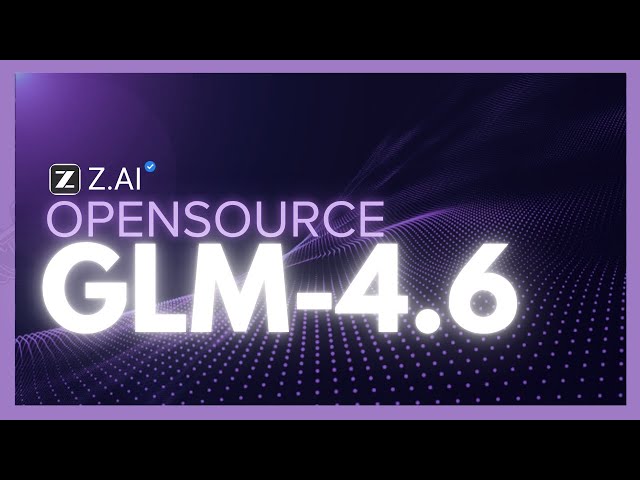Zhipu GLM 4.6: The Open-Source Frontier AI Revolution

TL;DR
- Only frontier-scale open-source model: 355B MoE with permissive MIT license—self-hostable, customizable, no vendor lock-in
- Near-parity with Claude Sonnet 4: 48.6% win rate on CC-Bench, still lags behind Sonnet 4.5
- Bilingual champion: #1 domestic model in China, SOTA for Chinese/English codebases
- 15% more efficient: Lower token usage = lower self-hosting costs
Zhipu AI's GLM 4.6, released in late September 2025, has established itself as the undisputed leader in the open-weight model space.
This is not just another open-source model—it's a frontier-scale (355B parameters) AI with MIT licensing, making it the only model in its class that enterprises can self-host, deeply customize, and own without API lock-in.
The Open-Source Advantage: MIT License at Frontier Scale
Release Date: Late September 2025
Architecture: 355B MoE | License: MIT | Context: 200K | Output: 128K
GLM 4.6's most significant feature is its license. It is a frontier-scale 355 billion-parameter Mixture-of-Experts (MoE) model released with a permissive MIT license.
What MIT License Means for Enterprises
- Locally deploy—no data leaves your infrastructure
- Deeply customize—fine-tune on proprietary codebases
- Own the model—no vendor lock-in or API dependencies
- Data privacy—meets stringent security/compliance requirements
The Strategic Advantage
GLM 4.6 is the only model in this analysis that an enterprise can locally deploy, deeply customize, and own without being locked into a proprietary API. This is a massive strategic advantage for organizations with stringent data privacy requirements, a need for fine-tuning on proprietary codebases, or a desire to avoid vendor lock-in.
Coding Performance: Competitive with Previous-Gen Proprietary Models
Benchmark Comparison
| Benchmark | Score | Comparison |
|---|---|---|
| CC-Bench (Real-World) | 48.6% win rate | Near-parity with Claude Sonnet 4 |
| vs. Claude Sonnet 4.5 | Still lags behind | Zhipu AI's candid assessment |
GLM 4.6 competes directly with the previous generation of proprietary models. On CC-Bench, a real-world, human-evaluated coding benchmark, it achieves near-parity with Claude Sonnet 4 (Anthropic's previous flagship). Zhipu AI's official blog is candid about its position, noting that while it competes with Sonnet 4, it "still lags behind Claude Sonnet 4.5 in coding ability".
Practical Strengths
Token Efficiency
The model is highly efficient, finishing tasks with ~15% fewer tokens than GLM-4.5. For self-hosted deployments, this translates directly to lower operational compute costs.
Frontend Specialization
Like Claude Sonnet 4.5, GLM 4.6 is praised for its frontend capabilities, specifically "generating visually polished front-end pages".
Bilingual Excellence: #1 Domestic Model in China
The model is highlighted as the "No.1 domestic model" in China. Its Hugging Face model card lists both English and Chinese as primary languages, making it a SOTA choice for:
- Development in Chinese language
- Managing bilingual (Chinese/English) codebases
- Processing bilingual documentation and comments
- International teams with Chinese operations
Beyond Coding: Agentic Capabilities & Creative Writing
Agentic Frameworks Integration
GLM 4.6 is designed for agentic workflows. It shows "stronger performance in tool using and search-based agents" and is integrated into multiple agent platforms:
Cline
Roo Code
OpenCode
"Refined Writing" & Creative Content
A key non-coding strength is its "refined writing" that "better aligns with human preferences in style and readability".
Creative Capabilities
- Performs "more naturally in role-playing scenarios"
- Praised for its "right sense of intuition" in creative writing
- Avoids the overly literal or rushed interpretations of other models
Long-Context Analysis: 200K Token Window
The 200K context window enables powerful, non-coding, long-context tasks. Analysis suggests it can ingest and analyze an "obsolete application with a sizeable legacy codebase... in one go".
Enterprise Use Cases
Legacy Code Analysis: Analyze entire codebases at once
Documentation Generation: Process large documentation sets
Research Analysis: Summarize extensive research papers
Data Processing: Analyze complex data structures
When to Use GLM 4.6
Data Privacy & Security Requirements
When your organization has stringent data privacy requirements, regulatory compliance needs, or operates in sensitive industries (finance, healthcare, government).
✓ Self-host on your infrastructure—no data leaves your control
Custom Fine-Tuning Needs
When you need to fine-tune on proprietary codebases, internal APIs, or domain-specific knowledge that can't be shared with external vendors.
✓ MIT license allows full customization and modification
Bilingual (Chinese/English) Development
When working with Chinese codebases, documentation, or teams. GLM 4.6 is the #1 domestic model in China.
✓ Native-level Chinese and English understanding
Cost Optimization
When you want to reduce long-term costs with self-hosting. GLM 4.6's 15% token efficiency means lower operational costs.
✓ No per-token API costs—predictable infrastructure expenses
Using GLM 4.6 with CodeGPT
CodeGPT provides seamless access to GLM 4.6 through OpenRouter, or you can self-host and connect directly.
- Connect to self-hosted GLM 4.6 instances
- Or use via OpenRouter for quick testing
- Full bilingual support for Chinese/English codebases
- Orchestrate with proprietary models: GLM for privacy-sensitive tasks, Claude/GPT for others
Ready to Use Open-Source Frontier AI?
Get instant access to GLM 4.6 with CodeGPT—whether self-hosted or via OpenRouter.
Get Started with CodeGPT